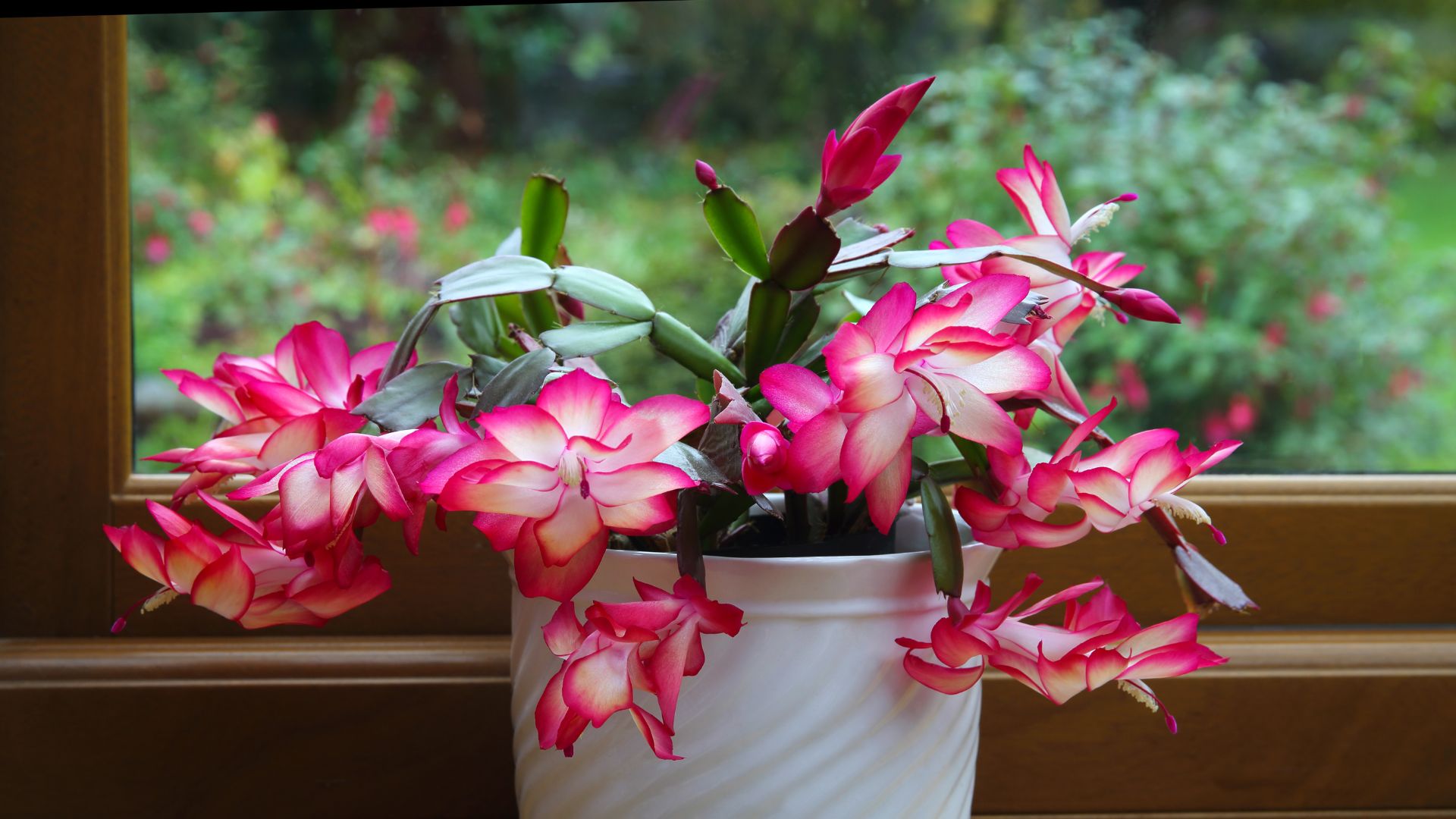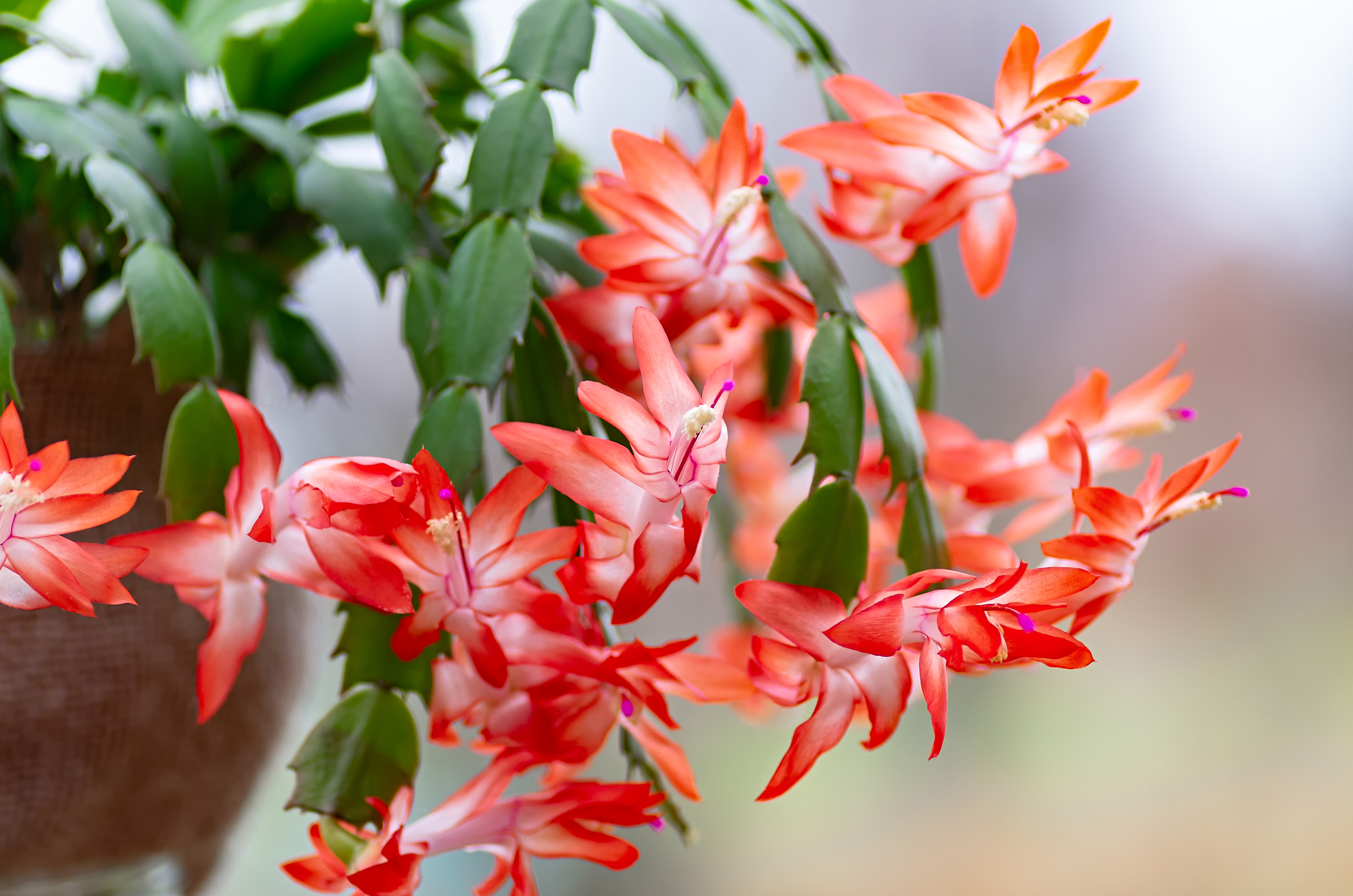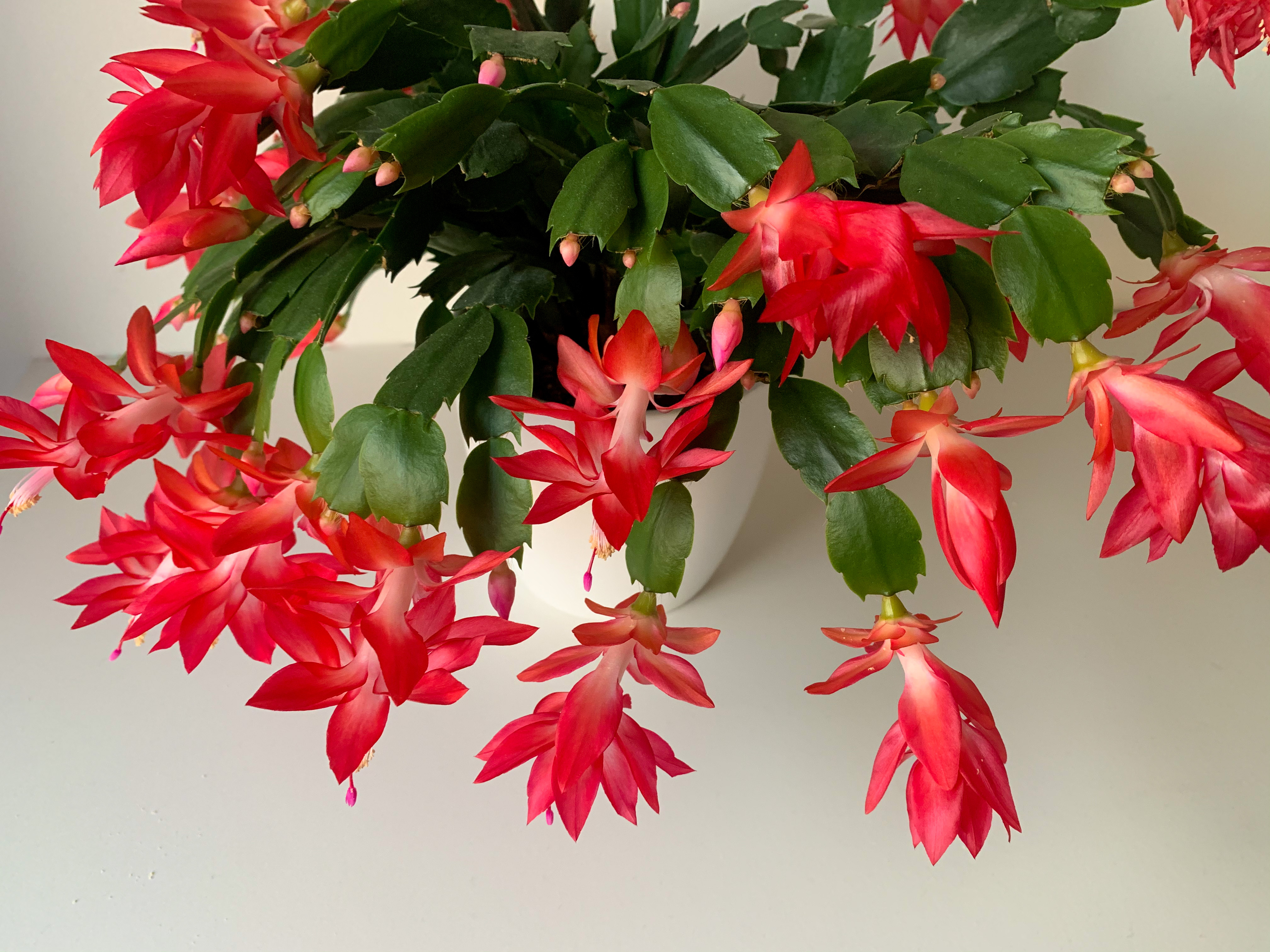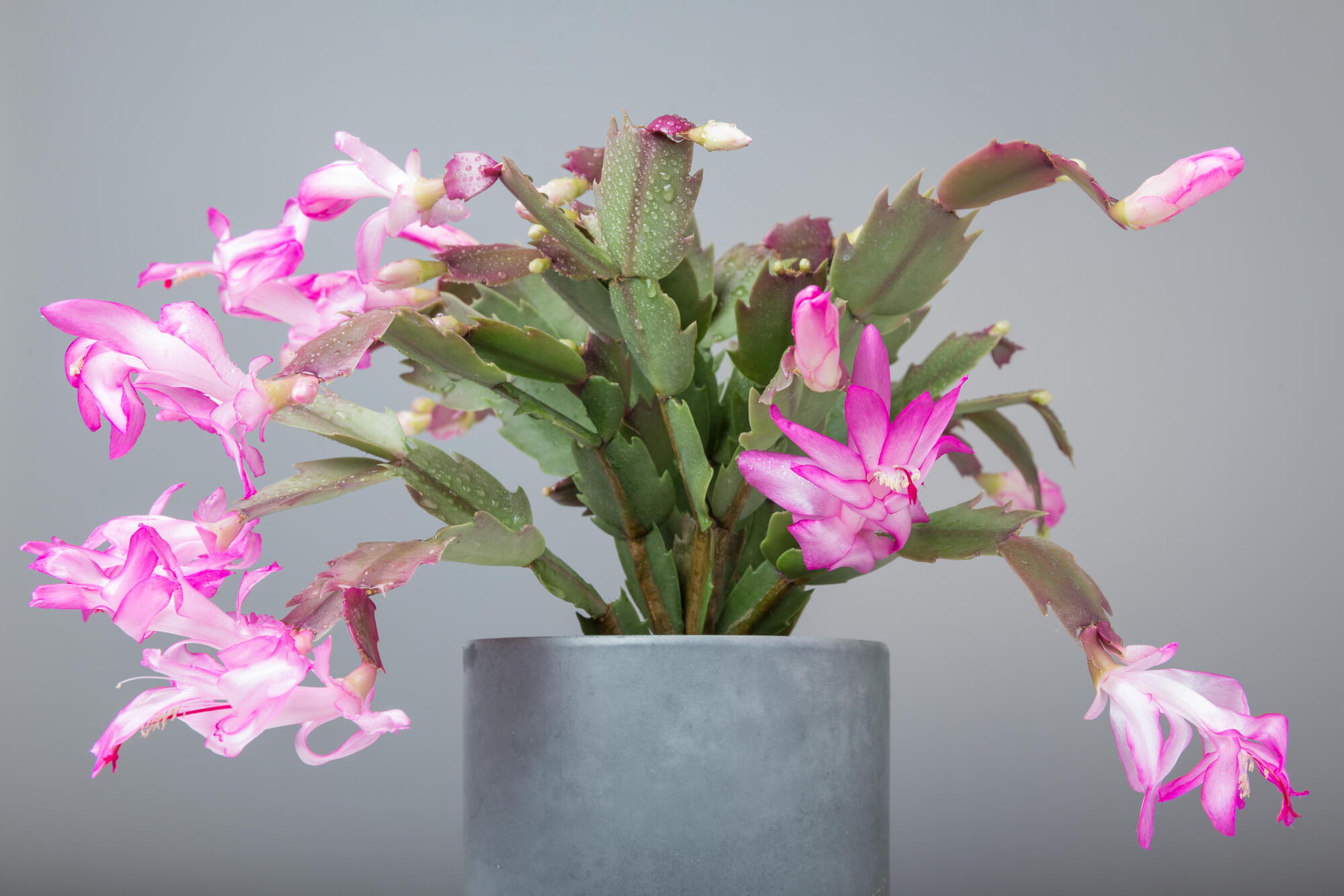
The Christmas Cactus, also known as Schlumbergera x buckleyi, is certainly a beautiful touch to the home. Aside from its joyful name, its beautiful color and leafy green foliage is what makes it a show-stopper. And though Christmas cactus care is quite easy, this plant can be quite particular about where it's grown. As it says in its name, this plant blooms during the holiday season, and can be found in an array of colors from shades of pink, red, and even white.
Native to southeastern Brazil, the Christmas cactus can thrive well in cool temperatures and loves to be kept away from any direct source of heat. Plant expert Tony O'Neill from Simplify Gardening, tells us this dynamic plant, "is a popular winter-flowering houseplant known for its bright, tubular flowers that typically bloom around the holiday season. Unlike desert cacti, Christmas cacti are tropical, meaning they thrive in more humid environments with indirect light. They are also known for their segmented, flat green leaves and long-lasting blooms."
If you want to bring the spectacular Christmas cactus into your home, it's important to know how to grow and care for it correctly — in order for it to be healthy and well developed. Here is everything you need to know about Christmas cactus care.
How to Care for a Christmas Cactus

Now, whether you've grown this type of holiday cactus in your home or simply welcomed and nurtured it from your local botanical store, there are still a few steps you need to take to grant this flower a long, healthy and thriving life.
Plant expert Tony O'Neill from Simplify Gardening says, there are a few things you'll need to keep your eye when it comes to the correct Christmas cactus care.
Sunlight: Christmas cacti prefer bright, indirect sunlight. Tony says, too much direct sunlight can cause the leaves to turn yellow or get sunburned. To prevent this from happening, Tony says "place it near a window with filtered light or in a room with plenty of natural light."
Watering: Tony says when watering, "water thoroughly but allow the top inch of soil to dry out before watering again. They don’t like soggy soil, so be careful not to overwater." Watering should be more frequent during the growing and blooming seasons, Tony emphasises, which is the spring through fall period — and less frequent during the winter dormancy period.
Temperature & Humidity: Thriving in a more humid environment, Tony says this plant loves to grow in "average household temperatures between 60-70°F. They also enjoy humidity, so occasional misting can help them stay hydrated, especially in drier indoor climates during winter."
Soil: For this, the expert says you should use well-draining soil, ideally a mix designed for cacti or succulents — like this Organic Potting Soil, Cactus and Succulent Soil Mix from Amazon. Adding a bit of organic matter, like peat moss, can help maintain moisture without making the soil too soggy.
How to Grow a Christmas Cactus

Known as being one of the best winter indoor plants, mainly for its color and easy going characteristics — the Christmas cactus certainly brings a touch of grace and boldness into a home.
If you want to grow this festive plant in your home, here's how you can do just that following a few simple steps from a plant expert.
Step 1: Choose a Pot - Tony recommends you pick a well-draining pot, "preferably one with drainage holes to prevent water from pooling at the bottom."
Step 2: Use the Right Soil - Use a cactus or succulent potting mix with good drainage. Choosing the right soil is essential to maintaining your plants health.
Step 3: Location - Next up, "place the cactus in a bright spot with indirect sunlight," says Tony. "Avoid areas with drafts or drastic temperature changes, such as near doors or heating vents."
Step 4: Watering Routine - Tony says it's best to water your plant when the top inch of soil feels dry to the touch. "Reduce watering during the winter dormancy period after blooming," he adds. Looking for the right indoor watering can? I love this chic Beech Wood Handle Watering Can, from Anthropologie.
Step 5: Fertilize - Once your plant is established, the expert says you should feed the plant with a diluted houseplant fertilizer once a month (we suggest the Miracle-Gro Liquid Plant Food from Walmart) — from late winter to early fall to encourage growth and flowering.
Step 6: Promote Blooming - Last, but not least, Tony says to encourage blooming, "move the plant to a cool room with less light in the fall (around 50-60°F) for a few weeks, and reduce watering slightly." The expert tells us that this will mimic its natural growing cycle and stimulate blooming.
Why Is My Christmas Cactus Not Flowering?

Are you wondering how to fix a limp Christmas cactus? Is your beloved plant having some blooming problems? Your plant may need some tender loving care if it's going through a tough phase. Tony says there are a few common reasons as to why a Christmas cactus might not bloom — these are:
Lack of light: According to Tony, If your plant does not get enough light, it could lead to a standstill in blooming. He adds: "They need bright, indirect light to bloom, so a spot that’s too dark may affect their blooming cycle."
Inconsistent watering: If you overwater or even underwater your Christmas cactus, it can become stressed — which may lead to fewer or no blooms.
Temperature stress: "Christmas cacti prefer cool temperatures (around 50-55°F) for 6-8 weeks before blooming," notes Tony. "If temperatures are too warm during this period, it can prevent bud formation."
Lack of dormancy: Another common problem would be If the plant doesn’t get a dormancy period in the fall. Even with reduced light and cooler temperatures, it may not bloom as expected.
And that's it! You've given yourself the chance to grow and care for this beautifully-hued houseplant and I promise you — you won't regret it. It will add warmth to your space with its color, even during the dull, crisp and cool winter season.
FAQs
Can You Grow a Christmas Cactus From a Cutting?
The simple answer is, yes! You can easily learn how to propagate a Christmas cactus and double or even triple these blooms in your home.
Here's how you can grow a Christmas cactus from cutting:
For the first step, Tony tells us to take a cutting from the plant, this can be done using sterilized scissors or shears. "Each cutting should have about 3-5 segments (leaf sections)," says Tony. As a next step, the expert says you should "allow the cutting to air dry for a day or two to let the cut end callous over."
Tony continues: "Place the calloused end in a small pot filled with a well-draining potting mix. Bury the bottom segment about an inch into the soil." Then, "lightly water the soil, and place the cutting in a warm, bright spot with indirect light. Keep the soil slightly moist but not soggy."
It will take about 2-3 weeks for the roots to form and for you to notice new growth. After a few months, you'll be welcoming a bright and beautiful Christmas cactus that it is ready to flourish.
Price: $24.99
Was: $29.99
Size: 4"
This American Plant Exchange Christmas Cactus Live Indoor Houseplant from Amazon, is easy to grow and care for. Adding a festive and enchanting feel into your home, this blossom will certainly bring in some delight during the dark winter season.
Price: $27
This Orange Christmas Cactus Plant from Walmart comes in a 4" pot and is easy to grow and maintain. Blooming in a beautiful orange shade, this plant will look wonderful housed in your living room.
Price: $24.95
Bringing a more toned down holiday feel, this White Christmas Cactus Live Plant will add specs of light into your space. Its beautiful white petals will add a sense of calmness into the home and best of all, they're long-lasting during the holiday season.







